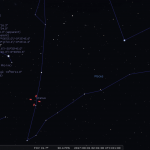The total solar eclipse hunters have now returned to the UK full of wonderful descriptions and plans to be in Chile in July 2019 for the next one; enough time to wash your socks and learn Spanish.
September is the month we say goodbye to Cassini. Having dropped off Huygens on Titan all those years ago, it has been busy undertaking scientific research that has rewritten a great deal of what we knew of Saturn, its moons and its rings. Friday 15th September at about 13:00 will see the probe re-enter Saturn’s atmosphere which to date it has only skimmed. Not designed for re-entry and an antennae trying to cling on to alignment with Earth through massive buffeting, the probe will be quickly lost before it gets too far into the thickening atmosphere. But this last measuring burst, with non-essential instrumentation switched off to maximize transmission bandwidth, will undoubtedly add a valuable epilogue to a spectacular mission. Find out more at:
https://saturn.jpl.nasa.gov/mission/grand-finale/grand-finale-orbit-guide/
And for those closer to home, the new observing season is kicking off. Good darkness will lengthen during the month from 6hr 20min to 8hr 40min. The start of the month has sunset at 19:55 and darkness by 22:00 and by the end, it’ll be 18:50 and 20:40 respectively. Hence you’ll no longer need to sacrifice sleeping for astronomy and loved ones may be more forgiving when you eventually go to bed.
Jupiter is still with us just and visible low in the south west from sunset but gone in little over an hour. It is worthwhile having a final look before it is lost to the Sun for a few months.
Saturn is due south at 20:00 at the start of the month and as low as Jupiter and so getting clear, crisp views is difficult but even if this gas giant is swimming around in your eyepiece it still makes a good view as long as you stick to lower magnifications. The brighter moons are visible and similar to Jupiter can be tracked night to night in their individual orbits

Source: Stellarium
If you do need your gas giant fix this month, then both Uranus and Neptune are available to you once the skies are dark. Both will require a Goto mount or a finding chart when you go out but are not too difficult to find in sm all to medium aperture scopes. Neptune is due south around 01:00 and Uranus around 04:30 but can be found in the south east from 23:00 each night.
Mercury, Venus and Mars are all morning objects with Mercury at its best around 10th September.

Venus rises shortly after 03:00 followed by Mars after 05:00 in the East Northeast. By the second half of the month, the early morning skies will get busy before dawn with the three planets and the waning crescent moon all close in the sky. Mars and Mercury will appear very close between 16th and 18th Sept and well worth getting up early. Venus wanting more attention will be passing M44 the Beehive Cluster from 31st Aug to 2nd Sept and offer a nice wide angle view with 90% illumination of the planetary disk.

Comet C/2017 O1 is improving moving through Taurus in September and worth a look through a medium scope as it is magnitude 10 or so and is still beaten by C/2017 Johnson V2 by a magnitude or so but they are in different phases and O1 has the potential to brighten further.
Full Moon is on 6th September with new on 20th. Hence the weekends of 16th and 23rd will be best placed for dark sky objects.
Keep looking up.
